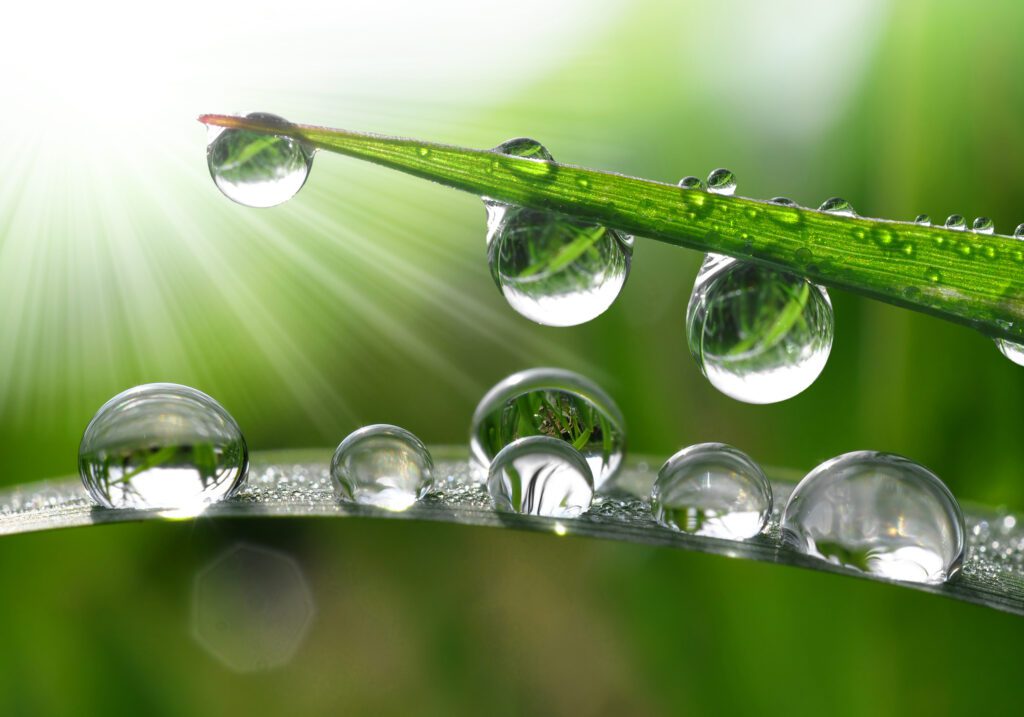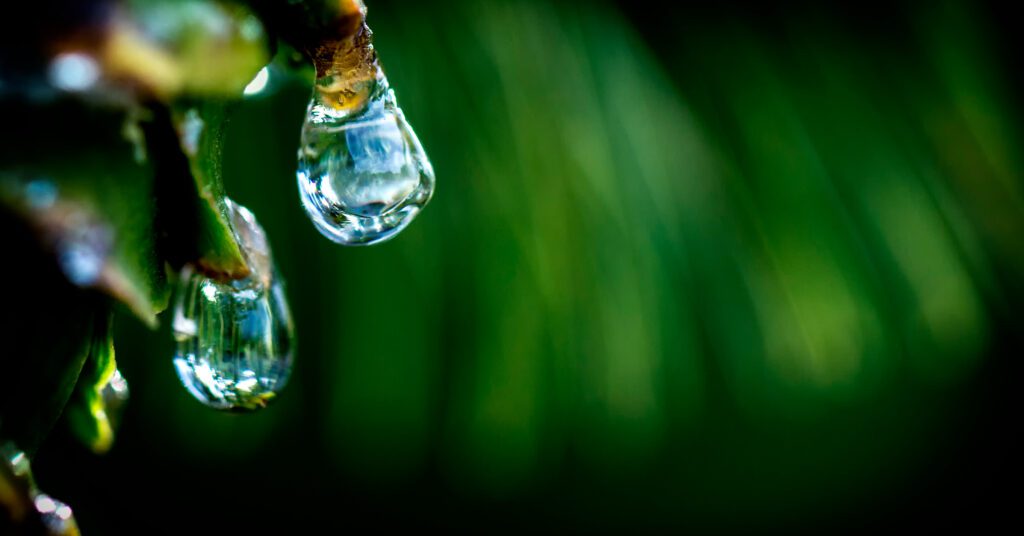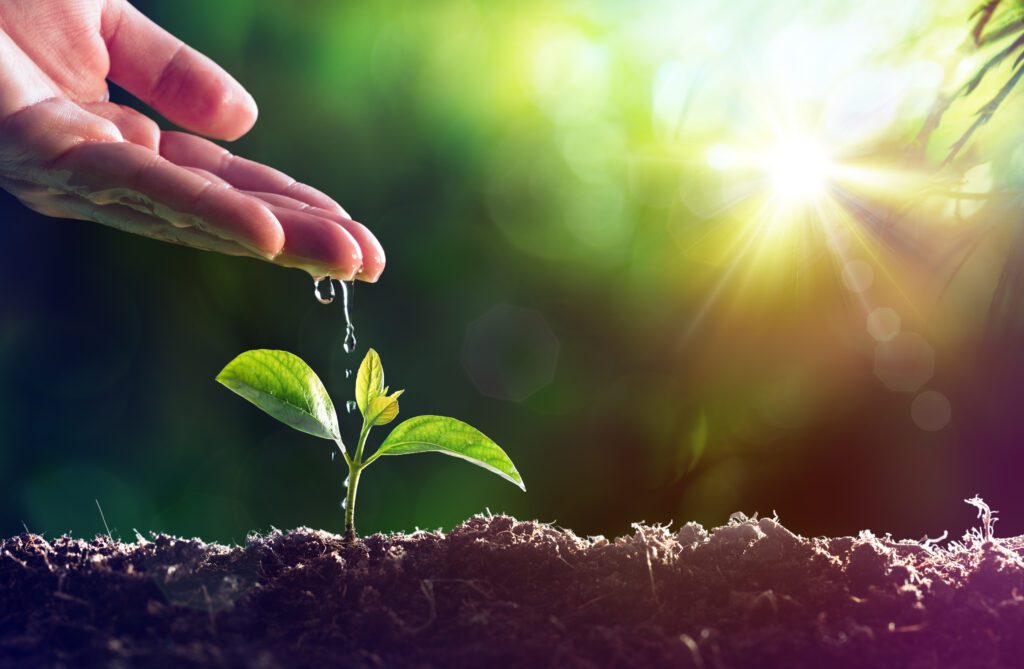
Learning How to Visualize
You’ve probably heard about visualization, right? You might remember, for example, hearing how that incredible basketball player visualizes his play beforehand, sometimes days before the game. And then, later on the court, he absolutely aces it. Yes, visualization has great potential for helping us to develop our skills and even change our behavior. It also is a valuable tool that we can cultivate in our meditation practice.
It consists of using our imagination to create a mental picture that, when used as part of our meditation exercise, can add layers of understanding and contemplation. The best place to start is by paying attention to our daily observations.
Daily Observations Inspire Visualizations
Let’s begin with a daily observation you’ve probably made, consciously or not so consciously, many times: Have you ever noticed dewdrops glistening in the sunlight early in the morning? Perhaps you see them outside the window, or while walking in the neighborhood. They sparkle with ephemeral beauty. And before you know it, they are gone. Evaporated.
Deepening into the continuous changes of all life and the precious moment of any given time can be a real window into living a more conscious life, grateful for what life brings our way.
It all begins with the observations you already make every day.
Think of other observations you make: the laughter of a child, the smile of a coworker, the rays of sunlight through the curtain, the soft fur of your cat, the green of early spring days: all these observations can be used in a visualization exercise. And each one can help us experience more deeply the sensations they may bring: joy, awe, inner peace, gratitude, beatitude.
There really is great potential for living life more fully by learning a meditation practice that incorporates visualization.
Visualization and Haiku: Similar Disciplines
After practicing the art of visualization for many years as part of my meditation practice, I discovered the short poetry form known as haiku. You’ve probably heard of haiku. It’s often taught in schools as a writing exercise as it is a short form of poetry consisting of three simple lines. It is of Japanese origin, perfected by a Buddhist monk hundreds of years ago.
I noticed something as I read and began to write haiku that for me was enlightening: haiku is actually a kind of verbal visualization.
It is a way of creating an image, using words to invoke an imaginative picture, with similar intentions as the imaginative picture we create when we visualize something in meditation. Both are about creating an image that will lead us to deepen into an idea or expand a moment of consciousness or come to appreciate a certain feeling or state of being.
Creating Images through Visualization
I began writing haiku about a year ago and got to know a community of writers dedicated to haiku. I found that it is a practice that is simple, and yet it requires effort and concentration, too. This is very much like meditation and the exercise of visualization, which also need effort and concentration.
Here is an example of one of my haiku that creates an image in order to ponder the fragility of life. It shows how, in just a moment, everything can vanish. I wrote it as an expression of our experience of time.

Did you notice the comments that followed the haiku on the preciousness of every moment? Some of the readers noted a parallel with human life: it shines brightly though it is only a brief moment within eternity. It is precious. And it is short lived. A remembrance or a realization of the fragility of life. The smallness of a human life. The fleeting nature of everything we experience.
In this way, the practice of visualization can lead us to appreciate life more. To realize more deeply how everything is a gift and how incredible it is to be alive at this very moment. The exercise of writing haiku is actually used as a Buddhist practice in much the same way that an imaginative picture can be used in a meditation practice.
Some readers have said that haiku, though deceptively simple, can raise awareness about the mystery of life and death, very much like a long essay on real life experiences can, leading us to ponder our relationship in the great circle of life.
Visualizing Time and Space
Let’s take a look at a second haiku. This one uses a flame to think about time. That moment that is eternal, that always is. When we use a flame in our visualization, it can center us in an increased awareness of the forces of nature, the basic elements of all the visible world, the movements of time and space, and the mystery of existence. When we visualize an imaginative picture, it is good to try to do it without describing it with words. To really see it in our mind’s eye. This can help us develop other ways of perceiving reality.
And now let’s turn our attention to a third haiku which contemplates the passage of time. Forty summers mark enough time for a small acorn to grow into a mighty oak. Three short lines strive to describe the changing of the seasons, the passing of the years, and the growth of a tree. Likewise, this could be an interesting visualization: an Imaginative Picture of an acorn growing through time until it is an immense oak. What kind of feeling might that awaken in you?
A fourth haiku looks at that wonderous mystery of the millions of years that went into forming the elements, the planets, our Earth and…. our human bodies. In fact, we really are made of star stuff, as Carl Sagan used to say. We are a miraculous part of the universe itself.

Visualization and Emulating People We Admire
We have seen how we can create Imaginative Pictures in our visualizations about nature and the visible world around us. However, there is another way to use visualization. And, perhaps, it has even more impact on how we choose and how we decide to be.
We can imagine a great person whom we admire, whose qualities we would like to emulate. As an illustration, think of Martin Luther King, Jr., who had a dream of equality and justice for all. Imagine his eloquence and great speaking skills. Above all, visualize his capacity for love in the face of discrimination and racial violence.
Again, we can find a parallel between visualization and this fifth haiku. It creates an image with words of this great leader and reminds us that we, too, are capable of love.

There are so many ways haiku can be used to express so much of our human experience.
Now let’s talk about what we call “Potential Meditation”.
I have to say that this is actually one of my favorite forms of meditation.
The exercise of the Potential Meditation consists of two steps: Invocation and Imaginative Picture. Each can be practiced for five minutes, when we are new at learning about meditation and, with time, we can extend each step to 10 minutes or even 15.
First, we direct our intention to the highest source of good and wisdom that we can imagine. Then, we state, in simple and direct language, what it is that we yearn for. Let’s try, for example, a meditation on the transitory nature of time.
Everything Passes, Change is a Constant
We might say, for example: “Open my awareness to the transitory nature of all of life. Help me to see the preciousness of every moment, and to really appreciate the beauty around me. May I become aware of how everything passes and that change is a constant in this life.” We can simple repeat these thoughts for five minutes.
During the second step, The Imaginative Picture, we concentrate on a single image for as long as we can. Maybe you’d like to try to hold the image of a golden dew drop in the morning sun. As we do this imaginative exercise, we strive to keep in check the emotions, associations, memories, or ideas that this image may evoke in us. This concentration allows the image to become engraved in our memory.
As with words, images are very powerful. We know how often things that made us suffer come back to our thoughts. It is a way that our mind tries to work through difficult emotions. The same thing happens with the image we create in the Imaginative Picture. It is working, on its own, in our mind. When we bring that image back throughout the day, we can begin to see clearly how to change our ways of thinking and feeling. Little by little we begin to appreciate all the small moments that make up our day. With practice, it can make a big difference in how we live our lives.
Visualization in the Affective Meditation
Well, you’ve read this article all the way until now, so perhaps you’d like to learn about another form of meditation where we use our visualization skills in an Imaginative Picture. It is a five-step meditation that works especially on our emotions, our affections, our ways of feeling. The Affective Meditation.
It is especially useful when we want to think about our relationships.

Paying Attention to our Behavior
For example, let’s say I want to learn more about my attitudes and how they affect my behavior.
I can create an imaginative picture of myself yesterday in a particular situation. I can see how I affected the other person with my words. This can help me see the harm I cause. Not easy to look at! Nevertheless, it becomes a concrete way to be humble, to learn, and to choose differently.
Moreover, this kind of exercise might lead us to open our minds and hearts to everything that’s going on around me. Everything we see and every piece of news we receive are messages from life. When we accept them, we understand and become more aware.
Consequently, it moves us to assume responsibility for what happens not only in my family but in the human family. We are, after all, inseparable from it. I can do something to make positive change.
Simple Steps to Visualization
The Affective Meditation consists of 5 steps, each practiced for 5 minutes. Invocation, Imaginative Picture, Sensations, Purposes, Consequences and then a short Summary of the meditation.
Let’s say I would like to meditate on my interactions with a coworker, one who usually ruffles my feathers a bit. So this is what I might do:
First Step
Invocation: Help me to discover a way to interact with this person, acting with kindness and patience, and going beyond my usual way of trying to avoid this person.
(Then I shift gently to the next step:)
Imaginative Picture: I see my heart open with genuine feelings of kindness and patience, reaching out to envelop my coworker as she sits at her desk working.
(Again, a gentle shift, as a natural flow to the feelings the visualization wakens:)
Sensations: I feel a deep yearning to commit to improving this relationship. I feel this yearning move me within.
(Another gentle glide, to what I will now do:)
Purposes: I will smile and speak kindly whenever I am with this person. I want to be kind. I feel that I am kind.
(And now a gentle flow into the results of the meditation):
Final Step
Consequences: I now sense a shift in my feelings towards my coworker, and I can act with authentic kindness now.
(A final short summary of the previous steps, ending the meditation with the word, “Peace.”)

So we’ve shared a glimpse into two wonderful meditation exercises that use an imaginative picture which we create through the art of visualization. Reading about meditation is good. Talking about it with friends is good. But the practice of it is even better, both alone and in groups with other people.
There is nothing like learning together. Whether the meditation is an outdoor class during the summer, or a class by zoom with people from around the world, guided meditations by experienced teachers is a great start to discovering the benefits of your own unique and special meditation journey.
About the Author(s)
Longtime teacher, now trying my hand at writing. Especially dedicated to people's real-life experiences.
Editor of collection of bilingual poetry, published by Cafh Foundation: Landscape of the Soul: Poems of Community and Hope by Hipólito Sánchez.
Translator of Living Consciously and Words Matter, by Jorge Waxemberg.





